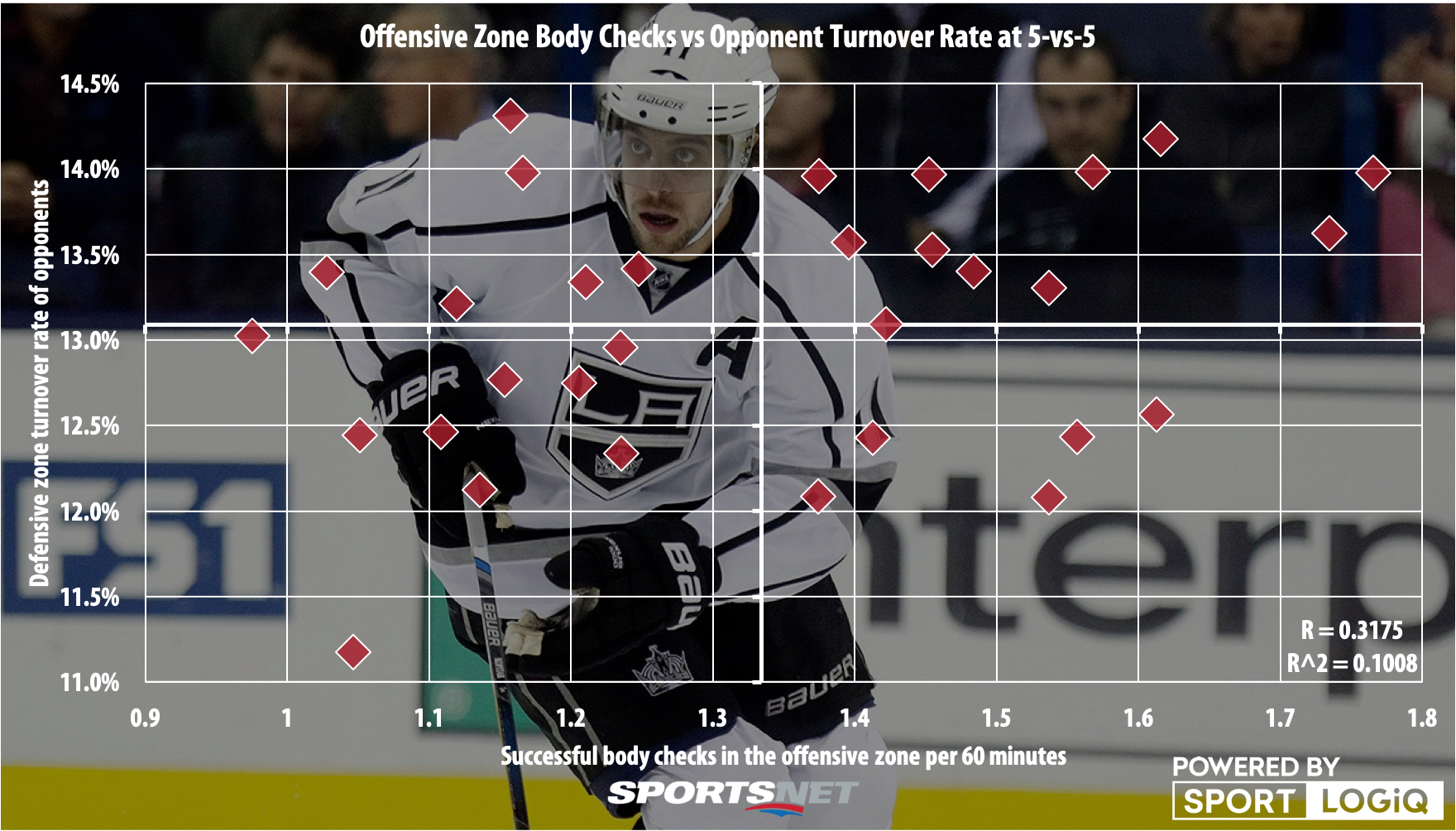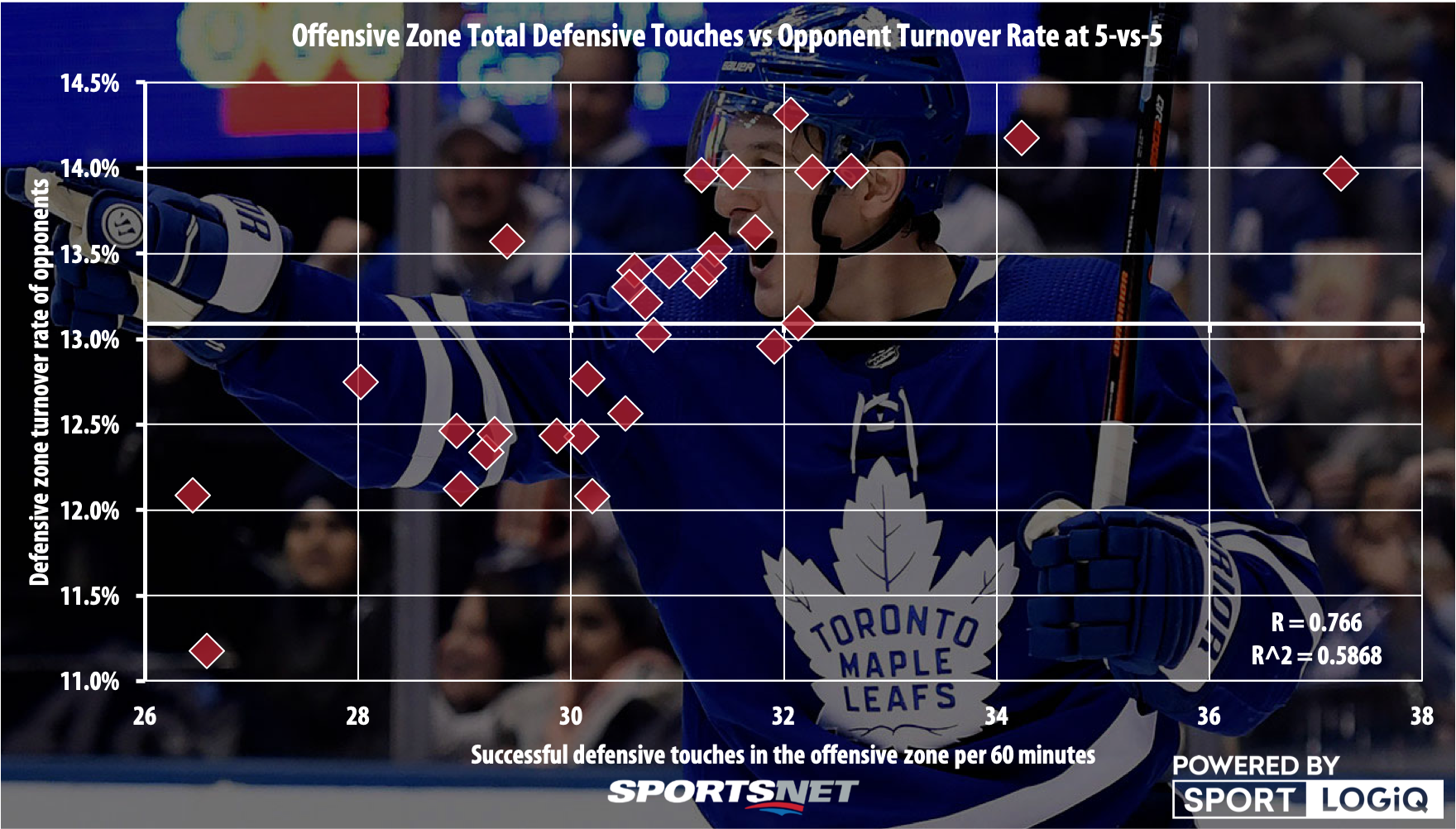Last week when I started Sportsnet’s analytics mailbag, there were a few questions that came in that were a bit heavier to answer than what a mailbag format can offer, so together with SN’s NHL Editor Rory Boylen we decided that if some questions were intriguing enough, we could expand them into full pieces.
One of those questions came from Matt, the cycle geek:
1) Is there any correlation between the number of hits players (or entire teams) receive and turnovers? Perhaps players rush their decision with the puck in order to avoid being hit.
2) Are aggressive PKs more successful than passive PKs?— Matt (@thecyclegeek) March 28, 2020
The second question is more of a video review type question, but that first one we can dig into with data in a robust way.
How does the number of hits a team lays out impact the turnover numbers of opposing teams? Hits are one of my favourite topics because the difference between what the NHL tracks and what is real is so vast. The NHL’s hit counters are extremely subjective, and most of the hits they record don’t occur on puck carriers.
In contrast, SPORTLOGiQ tracks only body checks that separate an opponent from the puck. As it turns out, those aren’t very common. The NHL’s listed hits leader this season is Ryan Reaves with 316, while the NHL’s true leader in successful body checks that remove possession is Jeff Petry with 60. Reaves himself only has 25, which is a gargantuan gap.
If we were to assume that the NHL properly tracked each ‘hit’ Reaves made, that would mean 92.1 per cent of his hits occur on players who don’t have the puck.
With that said, how much does hitting or body checking correlate to forechecking pressure and creating turnovers? Let’s use the offensive zone as our testing ground, and contrast each team’s offensive zone body checks with the turnover rate of their opponents in that zone. As usual, the axis are set at league average values.

Plotting each team here, we can see a few things. One, the gap between the teams that complete the most offensive zone body checks per hour of 5-on-5 hockey and the least is not large. They aren’t a common event. Two, the relationship between body checks and opponents’ turnover rate in their own zone is very slim.
The correlation coefficient between the two data sets (represented by R in the bottom right corner of the graph) is very low, and the coefficient of determination (R squared) shows that these two datasets do not have a reliable impact on each other.
While that answers Matt’s question, what can a team do to drive turnover rates of opponents? Some teams experience opponents turning over the puck as often as 14.3 per cent of the time they make a play in their own zone, and then the Ottawa Senators are barely above 11 per cent. Let’s look at some other methods teams use to apply pressure on the forecheck.

On the surface stick checks look like a safer bet since they’re less spread out than the body checks were, but overall their spread is actually even less correlated to turnover rates than body checks.
Stick checks that remove possession from the opponent are over three times more common than body checks that do the same, but they’re still not that common overall, and the extra volume doesn’t actually correlate more to forcing turnovers.
[snippet id=4167285]
What about getting into lanes? Blocking passes not only cause turnovers, they are directly the result of a turnover. So how well do they correlate to opposing teams’ turnover rates?

Hey there, now we’re talking.
With a correlation coefficient of 0.7637, and a tight grouping of teams close to what a trend line would look like, we’ve found something that actually has a huge impact.
Blocked passes have the two-fold advantage of directly being turnovers, and occurring at a vastly greater volume than stick and body checks. And the results speak for themselves here.
That team in the far right with over 30 blocked offensive zone passes per hour of 5-on-5 time is the Carolina Hurricanes, who are easily the most aggressive forechecking team in the league this season.
So we know that positional defence in the offensive zone causes more turnovers from the opposition, but what happens if we combine all these metrics together? Beyond being sound positionally to get in passing lanes, does being aggressive on the puck itself make the correlation even greater?

Maybe it shouldn’t be much of a surprise considering pass blocks constitute about 80.6 per cent of all defensive touches in the offensive zone, but there isn’t much of a change when you factor in direct plays on the puck carrier.
The correlation increases a little bit, but not nearly as much as you might expect, which leads me to believe that most of what creates turnovers in an opponents’ own end is positional awareness and passive puck pressure.
What I mean by passive puck pressure isn’t that teams should be passive in their approach to forechecking, but that they don’t necessarily need to actively engage with the puck carrier in order to force something to happen.
Take Zach Hyman for example. He doesn’t remove possession from opponents very often. He doesn’t block a lot of passes either. His forechecking contributions come from applying pressure on puck carriers to make a move more than actually catching them.
With the pressure on, Hyman’s teammates can anticipate a little bit of panic as opponents hurry to move the puck, and execute their play by getting into the passing lanes.
There are other factors baked into a team’s turnover rate as well, like team talent and the structure a team plays with as imposed by their coaching staff, but it’s interesting how differently forechecking is executed than what many might assume.
[relatedlinks]






